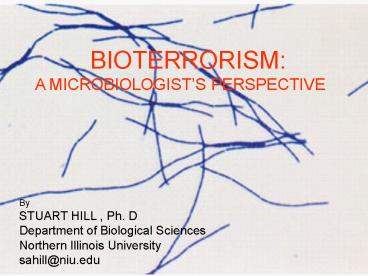BIOTERRORISM: - PowerPoint PPT Presentation
1 / 29
Title:
BIOTERRORISM:
Description:
Infectious disease complacency in the US. overall high standard of living. clean water supply ... 1997 'avian flu' influenza A (H9N2) 1999 bird isolate ... – PowerPoint PPT presentation
Number of Views:151
Avg rating:3.0/5.0
Title: BIOTERRORISM:
1
BIOTERRORISM A
MICROBIOLOGISTS PERSPECTIVE
By STUART HILL , Ph. D Department of Biological
Sciences Northern Illinois University sahill_at_niu.e
du
2
BIOTERRORISM A MICROBIOLOGISTS
PERSPECTIVE
basic infectious disease principles
- current problems - host/microbe interactions
potential bioterrorist threats
- anthrax
- smallpox - influenza
future threats
- genetic engineering - test tube evolution -
genomics revolution
3
Caveat exemptor
4
(No Transcript)
5
Infectious disease complacency in the US
- overall high standard of living
clean water supply
great health care systems
ready availability of antibiotics
comprehensive vaccination programs
6
(No Transcript)
7
Current infectious disease threats
- Emergence of naturally hypervirulent strains
Emergence of drug resistant bacteria -
Staphylococcus aureus MRSA strains -
MDR-tuberculosis
Bioterrorism
8
Seige of Kaffa Ukraine
Black death Europe 25 population died
WWI - targeted livestock -
Burkholderia mallei (glanders)
- Bacillus anthracis (anthrax)
9
Factors that influence disease
- transmission
correct portal of entry
e.g. subcutaneous vs. lung infection - anthrax
dose
e.g. 10,000 spores required for lung infection
host defenses
10
transmission
potential bioterrorist routes
- respiratory/aerosol
e.g. smallpox, pulmonary anthrax, tularemia,
melioidosis, psittacosis, Q fever
fecal / oral route
e.g. brucellosis, Escherichia coli O157H7
water contamination
e.g. cholera, cryptosporidiosis
vectors
e.g. plague, viral hemorrhagic fevers, viral
encephalitis, typhus fever
11
Host defense mechanisms
- chemical / physical barriers
- mucosal epithelium vulnerable
phagocytic cells
- macrophages - neutrophils
lymphatic system
- delivery of infectious agents to fixed
phagocytic cells
- often exploited by pathogenic organisms
inflammatory response
- recruitment of phagocytic cells to site of
infection
12
Host defense mechanisms
- chemical / physical barriers
- mucosal epithelium vulnerable
phagocytic cells
- macrophages - neutrophils
13
Host defense mechanisms cont.
active immunity
- humoral immunity (antibody) - cell-mediated
immunity (T-cells)
14
Bacillus anthracis
15
(No Transcript)
16
Anthrax vaccines
Sterne vaccine - attenuated strain
toxin capsule minus animals
Current vaccines manufactured in US and UK
PA plus small LF plus aduvant
New generation vaccines
Mutate various sites within PA, EF and LF
DNA vaccines
PA63 mutant plus mutant LF work synergistically
in mice protective immunity against LFfactor
challenge
17
Smallpox
orthopoxvirus (enveloped ds DNA)
- variola strain - limited host range (humans
and monkeys)
officially declared eliminated by WHO
in 1981
18
lethality 40-50
19
Smallpox
vaccine available
- live attenuated vaccina strain
20
influenza
orthomyxovirus
- segmented ssRNA - three types A, B or C
highly infectious
- 20-30,000 deaths/yr in US
antigenic variation
- Hemagglutinin (H) - Neuraminidase (N)
- monitored continuously
hypervirulent strains
- birds and pigs
21
pandemic potential
1918 Spanish flu
- influenza A (H1N1)
- deaths 500,000 US 40 million worldwide
- future pandemic strains influenza A
(H5N1) 1997 avian flu influenza A
(H9N2) 1999 bird isolate
22
Role of Birds and Pigs in Genetic Variation of
Influenza Virus
23
Influenza Vaccines
- Egg-derived (formaldehyde-treated)
- - essentially, one dose per egg (100 million
doses needed) - Reverse genetics
- - allows mix and match
- - rapidly accelerate production
- - standard reference strains
- - H5 strains kill embryonic eggs
- Live vaccines
- - use NS1 mutants
- - more effective immunologically administer
intra-nasally
24
Enhancing the potency
- Genetic engineering
- construction of multi-drug resistant
microbes
- mix and match of virulence determinants
e.g. cloning heterologous toxin genes into
pathogenic strains
- creation of supervirulent strains
e.g. creation of the killer recombinant mousepox
virus carrying the gene for IL-4
(Jackson et al., J. Virol 75 1205, 2001)
- creation of stealth viruses
25
Enhancing the potency cont.
- Test tube evolution (DNA shuffling)
- millions of years of evolution can be achieved
overnight with strong phenotypic selection
- creation of more potent toxins drug
resistance genes
- construction of complete novel genomes from
one or more microbes
project currently underway to determine the
minimum genetic requirements for a free
living organism
- de novo construction of viral genomes using
synthesized oligo-nucleotides
e.g. chemical synthesis of virulent polio virus
(Cello et al., Science 297 1016, 2002)
26
Enhancing the potency cont.
- the genomics revolution
- human genome sequenced
- 70 bacterial, fungal and parasitic pathogens
sequenced
identifies potential bacterial genes
- virulence - colonization - immune
evasion - antibiotic resistance
exploit human defenses
27
The genomics revolution cont.
proteomics
- reveals the subset of genes within a
microbe that are required for virulence
microarray analysis
- the order in which they need to be turned-on
designer diseases
28
Bottom line
- more likely to die of influenza than
anthrax
- emerging antibiotic resistance potentially
greater threat than bioterrorism
29
Factors that influence disease
- transmission
correct portal of entry
e.g. subcutaneous vs. lung infection - anthrax
dose
e.g. 10,000 spores required for lung infection
host defenses































